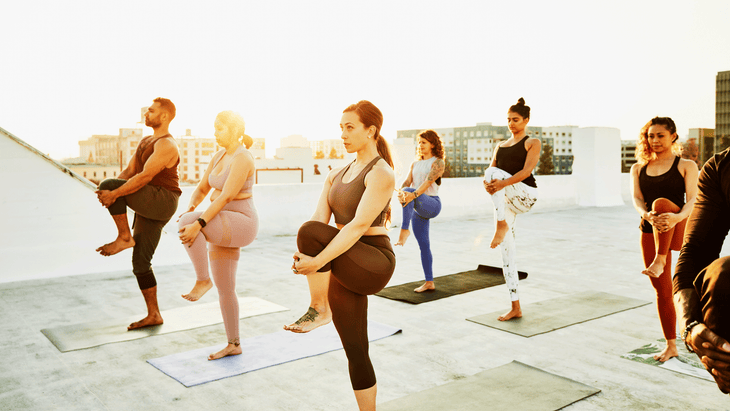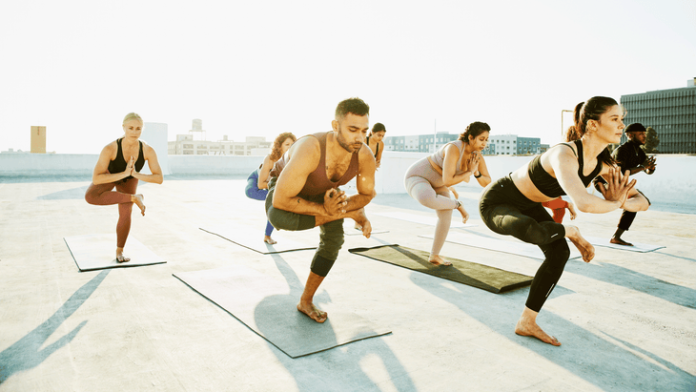“], “filter”: { “nextExceptions”: “img, blockquote, div”, “nextContainsExceptions”: “img, blockquote, a.btn, a.o-button”} }”>
Heading out the door? Read this article on the new Outside+ app available now on iOS devices for members!
>”,”name”:”in-content-cta”,”type”:”link”}}”>Download the app.
Whether you’re just getting started with yoga or years into your practice, you’ve probably experienced a common conundrum: you think you need to be better at yoga balance poses before you can do them but doing yoga balance poses is how you become better at them. It’s a lot like when you’re applying for a job and you need experience to land the gig but you need the gig to get experience.
Much like how you can volunteer or land an internship to gain the needed experience, you can practice balancing in yoga while still improving your balance. You simply need to allow yourself a little time to develop your skills. The following tactics can enhance your steadiness in yoga, whether you feel like you could topple just coming to standing at the front of the mat or are looking to lift one leg to the side without looking.
10 Ways to Stay Steady in Yoga Balance Poses
Whether both feet are on the mat in a standing pose or you’re balancing on one foot, the following suggestions can help remind.
1. Focus On Your Foundation
Yoga teachers commonly tell students to “ground into the mat,” but if you’re new to yoga, you may be unsure what this even means let alone know how to practice it.
The cue essentially means that you can’t build a stable building with a shoddy foundation. If you want to stand on one or both legs in a yoga pose without toppling over, you need to find a strong base of support. This starts with always being aware of the points of connection between your body and the mat. In other words, that means pay attention to your feet.
More specifically, try to isolate the exact points on your feet that are pressing downward into the mat. Think about growing deep long roots from the base of each toe, the ball of each foot beneath the big toe, and the heels into the mat. At the same time, gently lift your arches so they can assume the shape of their natural curvature.
By visualizing the exact points of contact between your body and the mat, you’re better able to focus on the sensations between your body and the mat. This, in turn, helps you feel more stable and supported, even when you wobble while trying to hold any standing yoga pose where both feet are on the mat but staggered or you’re balancing on one leg.
By trying to visualize the exact points of contact between your body and the mat, you’re better able to focus on the sensations of your body being supported by the mat in the necessary places.
2. Ditch the Socks and Shoes
Maintaining your sense of physical balance requires complex interactions between numerous systems in your body, including visual input from the eyes, the vestibular system located in the inner ear, and tactile feedback from your point of connection with the ground.
If you’re going to focus on your foundation, you have to be able to feel what’s beneath you. Practicing yoga in your bare feet allows all of the tactile receptors on the soles of your feet to have maximum exposure to the mat without socks or shoes blocking that input.
3. Connect to Your Foundation
After you’ve created a strong connection between your body and the mat, you’re ready to move your attention upward. Think of your body as a set of interconnected beams. Starting from your foundation, or feet, imagine setting up each beam sequentially in the proper position.
For example, if you are standing in Tree Pose, focus on standing tall with your shin vertical and stack your joints so that your knee is right over your ankle.
Then, continue upward to the thigh, keeping your leg upright and your joints stacked rather than leaning off to the side. The crest of both hip bones should be at the same height rather than one slouching lower than the other.
If you’re standing upright, your spine should be straight with your shoulders stacked over your hips. Finally, think about drawing the crown of your head toward the sky. Imagine a bunch of helium balloons connected to the top of your head and lifting you toward the ceiling.
4. Use Your Muscles
We often think of standing as a passive process in which we rely on our bones and joints to keep us upright. But standing yoga poses should never be passive, particularly if you’re trying to improve your balance. The best way to find and hold alignment in a pose is to contract your muscles.
That means engaging the small intrinsic muscles of the feet to help as you spread your toes wide and lift your arches. It also means activating the smaller stabilizing muscles in the shins and calves as well as the quads and hamstrings. And engaging the muscles of your core—including the back, glutes, and pelvic floor—can contribute in surprising ways to your steadiness. You learn to engage these muscles as you continue to practice yoga with self-awareness. It simply takes time and experience. One simple way to engage your core is to push through your heel—both in your standing leg and your lifted leg.
5. Use Your Gaze to Stabilize
One of the best tips for improving balance for yoga is to fix your gaze on a stationary point straight ahead. In yoga, this technique is called drishti, which means steady and concentrated attention.
For example, if you are in Extended Hand-to-Big Toe Pose or Low Lunge and find yourself teetering, choose something immovable straight ahead in your line of vision, such as a spot on the wall, and keep your eyes glued to it.
This keeps the visual input coming into your body constant and can help steady the fluid in the inner ear canal, which is responsible for detecting changes in the vestibular system.
6. Use Your (Entire) Core
We already discussed the fact that any yoga balancing pose requires the active engagement of your muscles to maintain proper alignment. However, it’s helpful to reemphasize the importance of engaging the entire core—including the back and glutes—to help you balance. Keeping the abdominal and lower back muscles nice and tight supports your spine and pelvis in a stable position. This will improve the stability of your entire body.
7. Breathe
Once you get into a balancing yoga pose, connect with your breath. Slow your inhalations and exhalations and keep your focus on your breath. This can help you stay present in the pose rather than thinking about other things. That focused attention on your body will help you maintain your alignment and balance. It will also train you to keep your focus during difficult moments in life.
8. Rely on Training Wheels
Remember that internship analogy earlier? There’s absolutely nothing wrong with using support, whether you’re still learning yoga balance poses or are simply experiencing an off day. Whether you’re practicing at home or at a studio, position your body near a wall or chair so that you can lightly hold on or reach out for support when you start to wobble.
9. Take Your Feet Wider
It’s normal to feel a little unsteady in standing poses in which your feet are grounded, such as Mountain Pose. Try spacing your feet a little wider apart so they’re hip-distance apart instead of touching to increase your base of support. Find your balance here.
Then try standing postures in which both feet are on the mat but they’re staggered, such as High Lunge and Warrior 2. If you feel wobbly, once again take your feet wider apart. Teachers often cue you to act as if you’re standing on railroad tracks and not a tightrope. That’s good advice.

10. Start Small
You don’t have to jump right into Warrior 3, Dancer Pose, or any other single-leg yoga balance poses. You can work on all of the previous suggestions—thinking about your foundation, finding your body alignment, actively engaging your muscles, focusing your gaze, and using your breath to help you feel stable and balanced—in any standing pose, including those with both feet touching the mat.
Start with basic standing postures that require both feet to be on the mat. Maybe you build up toward more challenging yoga balances poses by first drawing one knee toward your chest and steadying yourself here.
Then explore some one-legged balance poses and be sure to give yourself grace and patience with your yoga practice. As with anything you learn, finding steadiness in yoga balance poses doesn’t dramatically happen overnight. However, sticking with your yoga routine will help you develop the self-awareness and balancing skills necessary to slowly and steadily evolve your yoga practice.











